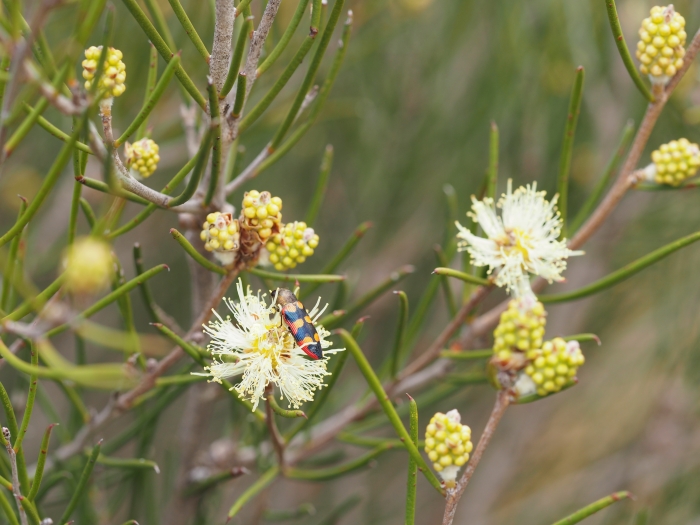Broom Honeymyrtle
(Melaleuca uncinata)
Broom Honeymyrtle (Melaleuca uncinata)
/
/

Geoff Derrin
CC BY-SA 4.0
Image By:
Geoff Derrin
Recorded By:
Copyright:
CC BY-SA 4.0
Copyright Notice:
Photo by: Geoff Derrin | License Type: CC BY-SA 4.0 | License URL: https://creativecommons.org/licenses/by-sa/4.0 | Uploader: Gderrin | Publisher: Wikimedia Commons | Title: Melaleuca_uncinata_(leaves,_fruits).JPG | Notes: {{Information |Description=* {{it|''[[Melianths major (L)]]'', Orto botanico [[Roma]], [[Italia]].}} |Source=self-made |Date=19 aprile 2008 |Author= [[User:Bolo77|Stefano Bolognini]] |Permission={{Self|Attribution}} |other_versions= }} [[Category:Melian













































Estimated Native Range
Summary
Melaleuca uncinata, commonly known as Broom Honeymyrtle, is an evergreen shrub native to the sandy plains and scrublands of Australia. This multistemmed plant typically remains under 2 m (6 ft 7 in) in height but can occasionally grow into a small tree up to 5 m (16 ft). The Broom Honeymyrtle is characterized by its dense foliage and distinctive, almost spherical flower heads that are 15–17 mm (0.59–0.67 in) in diameter, appearing in the leaf axils. The flowers, blooming from August to December, range in color from white to cream or yellow and are known for their attractiveness to birds. Following the flowering season, the fruit forms tightly packed clusters, each 7–13 mm (0.3–0.5 in) in diameter.
The Broom Honeymyrtle is valued for its hardiness and the ornamental quality of its flowers, which add a splash of color to gardens. It is often used in cultivation for habitat restoration, as a windbreak, and in ornamental plantings. This shrub thrives in full sun and can tolerate a range of water conditions, from low to medium, preferring soils with good drainage. It is relatively low-maintenance, making it suitable for gardeners seeking resilient plants. However, it can be susceptible to root rot if overwatered or planted in poorly drained soils.CC BY-SA 4.0
The Broom Honeymyrtle is valued for its hardiness and the ornamental quality of its flowers, which add a splash of color to gardens. It is often used in cultivation for habitat restoration, as a windbreak, and in ornamental plantings. This shrub thrives in full sun and can tolerate a range of water conditions, from low to medium, preferring soils with good drainage. It is relatively low-maintenance, making it suitable for gardeners seeking resilient plants. However, it can be susceptible to root rot if overwatered or planted in poorly drained soils.CC BY-SA 4.0
Plant Description
- Plant Type: Shrub
- Height: 10-15 feet
- Width: 10-15 feet
- Growth Rate: Moderate
- Flower Color: White, Cream, Yellow
- Flowering Season: Winter, Spring
- Leaf Retention: Evergreen
Growth Requirements
- Sun: Full Sun
- Water: Low, Medium
- Drainage: Medium
Common Uses
Bee Garden, Bird Garden, Butterfly Garden, Hedges, Hummingbird Garden, Low Maintenance
Natural Habitat
native to the sandy plains and scrublands of Australia
Other Names
Common Names: Broombush, Brushwood
Scientific Names: , Melaleuca uncinata, Melaleuca nodosa var. stenostoma, Myrtoleucodendron uncinatum,
GBIF Accepted Name: Melaleuca uncinata R.Br.